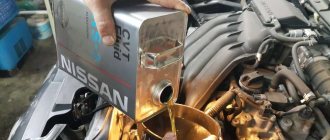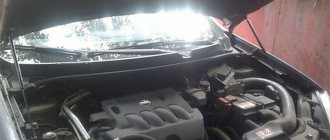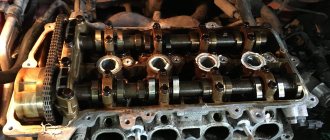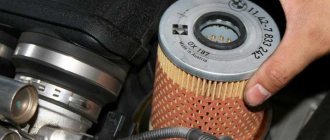How to start a car after changing the oil?
You can start the car only after placing it in a horizontal position according to the following scheme:
- The car idles for 5 minutes;
- then, with an interval of 20 seconds, the gears are switched to each gear in order, then the actions are repeated, but in the opposite direction;
- you need to drive smoothly along the road without jerking or slipping;
- return to the garage site and repeat on the spot changing gears in all modes in one direction, then in the opposite direction (from D to P);
- then you need to check the oil level in the gearbox with a dipstick while the engine is running;
- If the oil level is exceeded, it can be topped up.
In practice, it has been established that the Nissan X-Trail filter must be changed after a maximum mileage of 15,000 km. Although some official service stations install a new filter after 30,000 miles.
Preparing to change the oil and filter on the mechanics
Before you get down to business, you should refer to the maintenance regulations. According to the schedule, every 15,000 km the driver must check the oil level in the gearbox. When the mileage reaches 90,000 km or 6 years have passed since the last replacement, it is necessary to fill in a new lubricant. If the check reveals that the fluid level is low enough, it should also be changed.
What fluid should I use for 1.6 MT 6CT? It is best, of course, to take factory gear oil. For example, a great option would be the Nissan MT-XZ Gear Oil TL/JR Type (to make it easier to search, write down the number - KE916-99935).
The volume required is small, so a 2-liter canister is sufficient. Viscosity may vary, depending on the operating conditions of the SUV.
Japanese Idemitsu brand oils perform well, so you can also safely take them for your Qashqai.
Don’t forget that the oil cooler filter is almost always replaced along with the oil, so you should immediately check before starting the whole process whether you have purchased a new part (it is also better to take the original one). During the procedure you will need a fairly solid set of tools:
- plastic tie clamp (2–3 pieces);
- several scraps of fabric (for wiping);
- flat screwdriver;
- spare drain plug;
- wire cutters;
- containers for waste liquids;
- Allen key 10.
How to check the quality of oil in a variator
The working fluid in the variator should not have an unpleasant burning odor; in addition, it should be clean. The oil at such a gearbox almost never smells like burning. However, if you find that the lubricant is contaminated, most likely there is something wrong with the box. Why can the working fluid become dirty? There are several reasons:
- The gears are worn out. Even if you take care of the condition of your car and add new lubricant every 15,000 km, the gears will sooner or later become unusable. Moreover, this problem most often happens on new cars, on which the gears have not been ground into each other. After grinding them in, a so-called filled mirror is formed. Of course, parts will still wear out, but not as much as in the first 10,000 km. Due to wear, chips settle at the bottom of the box; magnets located in the transmission are used to retain them. Because of these microparticles, the lubricant becomes dark in color and becomes dirty.
- The gearbox parts have become unusable. For example, in an automatic transmission the friction linings fail, and in a variator the belt and mirrors of the drive discs wear out severely. One way or another, this process leads to the formation of dirt that settles in the lubricant and filter element.
- The gearbox is dirty. A little dirt penetrates (through the dipstick, plug or vent), but this is enough for the lubricant to turn black.
- High temperature operating mode. The functioning of the automatic transmission and the variator is inextricably linked with high temperatures. The automatic transmission heats up to 150°, for example, in the hot season, when the car is stuck in a traffic jam. Under such operating conditions, the oil becomes dark, it either heats up or cools down, and over time its properties change. Modern transmission oils can withstand high temperatures, but after 60,000 km, 50% of their properties are lost. Therefore, it may be necessary not only to check the oil in the variator, but also to replace it.
- The cooling radiator has failed. Due to the fact that the gearbox operates at high temperatures, cooling radiators are used on automatic transmissions and CVTs. This is the only way to maintain the optimal temperature: 80–90°. But when the radiator becomes clogged, the lubricant overheats. It does not enter the cooling cavity and begins to curl at high temperatures. Of course, if the radiator breaks down, symptoms will appear that the variator is faulty: box jerking, slipping, “kicks”.
For the above reasons, the oil in the variator most often becomes contaminated and needs to be checked. What will happen if you do not replace the working fluid in the automatic transmission and the variator? The box will fail. Besides:
- The filter elements will become dirty and will not allow lubricant to pass through. Therefore, the working fluid will turn black, it simply will not be cleaned;
- the valve body becomes clogged; it is this unit that supplies and distributes the pressure of the working fluid in the variator; you can forget about the normal functioning of the box;
- the oil pump will fail, as a result, the clutches on the automatic transmission will burn, and the belt on the variator will spin, and scuffs will appear on the shaft mirrors. As a result, the box will completely fail and it will be quite difficult to repair it;
- The radiator will become clogged, the grease inside will begin to burn and become thick.
To summarize, it is worth noting that if you do not check and change the oil in the variator, the box will quickly fail. If you do not fill in new working fluid, the gearbox will have to be repaired after 90,000–100,000 km.
What kind of oil should I pour into the variator? Select ATF.
For a long time, domestic motorists avoided a continuously variable transmission or simply a variator.
But recently, the situation in the automobile market has begun to change, if not radically, then at least noticeably: more and more often, motorists are choosing car models with CVT. This trend has emerged due to two main factors: more and more famous manufacturers of transport equipment began to equip passenger cars and SUVs with CVTs; Today, this type of gearbox has been almost completely studied, and the main advantages and disadvantages of CVT are known. Specialists and entire workshops regularly appear offering their services for the repair and maintenance of continuously variable transmissions. Getting parts, consumables and components for it is no longer a problem even in a small city.
Is it necessary to change the oil?
After 30-40 thousand kilometers traveled, the oil begins to lose its ability to effectively perform its tasks. The intensity of the loss of properties is largely related to the unfavorable conditions listed above. That is, the more often and more aggressively a car is used, the faster the ATF becomes unusable. It becomes contaminated with metal shavings - a product of wear and tear on the mechanical parts of the box. Deterioration of oil quality has a destructive effect on the components of the CVT - belt, pulleys.
And if you consider that the variator has a hydraulic unit - one of the most expensive parts - then the oil change must be carried out not only in a timely manner, but also responsibly. Refer to the original oils and all the instructions specified by the component manufacturer in the instructions. You may have noticed that ATF fluid may be red or green in color. You cannot mix two substances of different colors. The best oil for your car's gearbox is the product indicated in the service book. This is where all acceptable brands are listed.
Video about proper fluid replacement
At the same time as replacing the fluid, experts recommend changing the filters and cleaning the magnets installed in the pan of the unit. The filter in the iron casing - coarse cleaning - is enough to rinse the first time, but during the next replacement it is best to replace it with a new one. The paper filter element - fine filter - should be changed each time at the same time as the ATF. It is best to clean the magnets that catch metal shavings thoroughly.
| Coarse filter | Fine filter |
If the oil level is less
If you find that your oil level is at or below a critical level, you need to urgently add fluid. For this purpose, in fact, the fluid level in the variator is checked on the Nissan Qashqai. The brand of oil, or its characteristics for choosing an analogue, is always indicated in the user manual. It is necessary to fill in oil of equivalent characteristics.
You can see the mark left by the oil on the opposite end of the handle: the level should be between the two notches. General method, cold engine and shutdown. Stop the car on a horizontal surface, wait four to five hours after stopping the engine so that all the oil has time to drain into the crankcase, including the torque converter oil.
Open the engine cover, find the dipstick, it is shaped like a ring or bright hook protruding from the transmission, pull it out and pull the metal rod all the way.
- Wipe the rod and replace it until it stops without waiting for it again.
- A guide to learn which tags to use.
Please note that automatic transmission oil is not manual transmission oil or motor oil: it is very thin and varies markedly according to the markings. Use only the one recommended by the vehicle manufacturer, at risk of rapid and irreversible degradation of the transmission
You don't have to look for a specific brand.
It is important that the fluid in the system and the one being added are identical. When topping up, you should understand that overfilling is undesirable.
This is why the maximum is marked on the dipstick. In order not to overfill the system, control measurements should be carried out, repeating the steps described above.
Locate the oil filler cap, it is always found on the top of the box and is usually identified by the oil can or oil can symbol. Do not add more oil than necessary; excess oil may damage the transmission. Be careful not to forget that the oil takes a while to get to the crankcase, wait a few minutes before checking the level again. The following describes how to check the oil level using the gauge.
The filling tube locking cap has a safety device that prevents accidental opening. Once this step is completed, you can finally add the remaining oil. Consequently, part of the sensor may protrude from the filling tube even if it is placed in the abutment.
- Park the car horizontally on its wheels.
- The filler tube is located in the engine compartment.
- Break the locking pin using a suitable tool.
- The locking pin can then be removed and the locking cap unscrewed.
- Move all gears briefly several times.
- The gear oil level should be between min.
- And max.
- If necessary, correct the oil level and repeat the check.
- Be sure to remove the dipstick after measuring the oil level!
- The locking cap can be secured with a new cotter pin.
Motor oil is the lifeblood of our car, the lubricant that allows it to travel thousands of miles without problems, but too many times we tend to forget about it.
CHECKING CVT FLUID Nissan Qashqai
CHECKING CVT FLUID
CHECKING THE FLUID LEVEL
The fluid level should be checked after it has warmed up to 50-80'C. Check the fluid level as follows:
1. Check for fluid leaks.
2. After warming up the engine, take a ride in the car. At an ambient temperature of 20*C, it takes about 10 minutes to warm up the CVT fluid to 50-80'C.
3. Stop the car on level ground.
4. Set the parking brake securely.
5. While the engine is idling, depress the brake pedal and move the selector lever through all ranges.
6. Remove the dipstick from the CVT fluid filler pipe. To do this, press the lock on the probe and unlock the probe.
7, Wipe off the fluid from the dipstick. Insert the dipstick by rotating it 180′ from its original position so that it touches the top end of the CVT fluid filler pipe,
Caution: Wipe CVT fluid from the dipstick with lint-free paper, not a rag.
8. Move the selector lever to the “P” or “N” position and make sure that the fluid level is within normal limits.
Attention: When inserting the dipstick into place, insert it into the CVT fluid filler pipe and rotate it to its original position until it is securely seated.
CHECKING THE CONDITION OF CVT FLUID
• If the CVT fluid is very dark or smells burnt, check the operation of the CVT. After repairing the CVT, flush the cooling system.
• If there are pieces of friction material (clutches, band brakes, etc.) in the CVT fluid, after repairing the CVT, replace the radiator and flush the radiator tube with a cleaning solution and compressed air. See chapter ENGINE LUBRICATION AND COOLING SYSTEM.
Deposition of sticky films
CVT fluid performance deteriorated due to high temperatures
Replace the CVT fluid and check for abnormalities in the CVT and the vehicle (wiring, radiator pipes, etc.).
Milky white or cloudy
Water has entered the liquid
Replace the CVT fluid and check areas where water may have entered.
Lots of metal powder impurities
Increased wear of rubbing components in CVT
Replace the CVT fluid and check if the CVT is working properly.
CVT FLUID CHANGE
1. Remove the drain plug and drain the CVT fluid from the oil pan.
2. Screw the plug into the oil pan drain hole.
Attention: Do not reuse the gasket.
Drain plug: Tightening torque: see chapter CVT.
3. Fill fluid through the CVT fluid filler pipe to the required level.
4. After warming up the engine, take a ride in the car. At an ambient temperature of 20'C, it takes about 10 minutes to warm up the CVT fluid to 50-80'C.
5. Check the level and condition of the CVT fluid.
6. If the CVT fluid is contaminated, follow steps. 1 -5 repeatedly.
CVT fluid: NISSAN CVT fluid NS-2
Liquid filling capacity: 8.3 l
Attention:
•I Use only genuine NISSAN CVT NS-2 fluid. Do not mix with other brands of liquids.
• Use of a CVT fluid other than NISSAN CVT NS-2 may adversely affect the performance and life of the CVT and will not be covered by the warranty.
• When adding CVT fluid, do not spill it on heat-generating components, such as the exhaust system.
• Shake the container with CVT liquid thoroughly before drinking.
• After replacing the CVT fluid, erase the date of the previous filling using the CONSULT-III tester.
Source: automend.ru
Hearing test
The most common problem is wear of the cone bearings. At the same time, an unusual hum appears. As a rule, this happens when the mileage reaches 50,000 km. Replacing all 4 bearings with the necessary additions will cost about 35,000 rubles.
At the same time, wear of the notches on the steel belt plates can lead to extremely disastrous consequences on the road, so replacing the belt will not be superfluous during any rearrangement of bearings. This problem is often found in Nissan Qashqai models, sometimes in Nissan X-Trail, and in Mitsubishi Outlander this malfunction appears only after 150,000-200,000 km.
variator bearings RE0F10A (JF011E)
You should not delay replacing bearings - with high-quality sound insulation and lack of driver attention, they can break and the cone can burst.
But if they make noise, they make noise for different reasons. First of all, worn particles come into contact with the functional surface and thus negatively affect the rate of its destruction. They inevitably penetrate there, since barriers in the form of a pair of oil filters and a magnet are not enough to hold them.
At the same time, the life of bearings can be extended by changing the oil every 50,000, or better yet, every 30,000. But this conclusion is based only on some observations; many experts do not see the connection here. Some CVTs live quietly up to 100,000-120,000 km, while others, under the same conditions of use, become noisy after 50,000 km. This means the issue is the low quality of the bearings. And sometimes bearings cannot cope with their work and its volume and wear out because of this.
The oil pump starts working immediately when the engine starts. This is a single mechanism that requires replacement when the pressure reducing valve fails. Meanwhile, it is very difficult to get a damaged and neglected valve. To ensure that the oil does not overheat, a liquid heat exchanger is built in, eliminating high temperatures using coolant.
variator oil pump
When it comes to changing the oil, there is no consensus. For example, the Renault-Nissan concern advises to simply monitor the correct oil level up to 100,000 km (with a warranty), while Mitsubishi asks to change it upon reaching 75,000 km.
It should be noted that even special oil is made for CVTs - marked “CVT”. Nissan makes the NS-2, and Renault recommends the ELFMATIC CVT. Mitsubishi recommends the DiaQueen CVT-J1. The most popular oil among them is “NS-2”, sold in 4 liters. But in essence, all these oils have the same base. However, using regular automatic transmission oil in a CVT is unacceptable. Although there are some such variators, these are rather atypical examples.
The amount of oil is also calculated based on the engine needs and the type of drive. For example, a rear-wheel drive Nissan Qashqai with a 2-liter engine in the absence of an oil cooler will need approximately 4.2 liters. In addition, several liters are still in the hydraulic system and transformer - this oil cannot be drained, and to completely change the oil they use a special installation, and under such conditions, 2-3 times more oil is needed.
Features of operation and when to change the oil
From a mechanical point of view, this is a common unit in which the lubricant is used not only for its intended purpose (reducing friction), but also as a hydraulic fluid.
Only, unlike a classic “automatic” with a torque converter, oil is used not to move the switching mechanisms, but to create the necessary pressure between the pulley halves.
In the control program for the mechanical part of the CVT, there is a linear correction “for aging” of the fluid. An internal meter gradually increases the pressure in the compression cylinders to compensate for lost hydraulic properties.
The specific period for changing the oil in the variator is determined by the car manufacturer.
For example, the official manuals for Nissan CVTs indicate that CVT oil is changed every 40-50 thousand kilometers (depending on the car model and the power unit installed on it).
At the same time, this period should be halved, provided:
- Driving in dusty conditions or in high mountains;
- For frequent short trips;
- When operating a vehicle in difficult climatic conditions;
- When driving on loose surfaces, on roads treated with reagents;
- When towing a trailer.
If you consider that even ordinary trips around the city in start-stop mode, slipping, sudden acceleration and stopping can already be considered difficult conditions, then it becomes clear that the box needs to be given special attention.
All these factors (and a number of related ones) lead to accelerated aging of the transmission oil and its loss of its physical properties, which is especially important for CVT.
In the road conditions of Vladivostok, the oil change in the variator should be performed every 30-45 thousand kilometers. At the same time, the replacement procedure, which includes about 20 successive stages in professional execution, has its own nuances for different models and generations of CVTs.
Filling with new technical fluid
New oil is poured in small portions of approximately 150 milliliters. This allows it to be evenly distributed throughout the volume and fill the cavities. Checking the level after filling is carried out on a warm engine. The verification algorithm was discussed earlier.
Errors when filling out are acceptable. It is not always possible to achieve the desired level the first time. If necessary, the excess volume can be drained or, conversely, filled to the required levels.
Resetting the Nissan CVT lubricant aging counter using a simple scanner
The algorithm itself involves taking into account the operating parameters of the motor and variator, correction factors that are set by the manufacturer taking into account the task of preserving the resource of the box.
If there is no MUT-III. automotive scanner designed for resetting, then you can reset the level of deterioration using an adapter and ELM-327 version 1.5
You should purchase such an adapter with caution, since unscrupulous sellers under the working version sell unsuitable devices (version 2.1)
Resetting the Nissan variator oil aging counter is carried out as follows:
- Download and install the program (for a smartphone or tablet);
- The adapter is inserted into the connector located near the hood release handle;
- The device is located via Bluetooth and the password 1234 is entered.
- The program starts, Data Monitor appears on the screen (the aging indicator is at the very bottom of the screen);
- In the main menu, press the “Read CVTF DETERIORATION“ button, which is responsible for resetting;
- If zeroing does not occur, the procedure should be repeated (possibly several times).
We recommend warming up the variator. How to do this correctly?
So, operating a cold variator, especially at very low temperatures, is harmful. It is advisable to warm it up. But among owners of cars with a CVT, there is no consensus on how to properly warm up a car with such a gearbox. On specialized forums there are constantly debates about methods of warming up. At the same time, many car owners try to apply the rules for warming up a classic automatic transmission to CVTs, and this is fundamentally wrong.
Warming up while moving
One of the options for warming up is warming up while driving. The point is that you immediately start driving without warming up, but do not “rape” the car for a certain time. That is, you move carefully, without sudden acceleration or braking, you press the gas pedal smoothly, you don’t accelerate the engine to high speeds, and you don’t move at high speed. Some people always drive like this.
In this case, both the engine and the variator warm up gradually as you drive, and the gentle “cold” mode does not allow the mechanisms to wear out too much.
Warming up in the parking lot
This method requires you to spend an additional 5-20 minutes before departure. We leave early, start the car and sit and wait until everything warms up.
Classic warm-up and start driving only after the car engine has warmed up. And along with the engine, the variator also heats up, since they are assembled together.
This method is actually used by everyone who has an automatic engine start from the alarm remote control installed. True, the variator warms up worse, because it only receives heat from the engine. The variator itself does not generate heat when there is no movement. In fact, the variator will warm up completely only after you start driving.
Incorrect warm-up similar to an automatic transmission
Many people are accustomed to warming up the automatic transmission while parked by switching it to the “Drive” mode, or alternately switching the “PRND” modes and back. And by analogy, and sometimes on someone’s advice, they also begin to warm up the variator. Yes, for a classic automatic transmission this is the correct method, since it allows you to “disperse” the oil through all channels of the “automatic” when switching modes. But the design of the variator is fundamentally different from the classic automatic, so switching modes practically does not change anything and does not improve warming. Perhaps, before starting to drive in cold weather, you can switch the “N” (neutral) mode for a few seconds to slightly stir up the starting fluid coupling (variator clutch). Thus, there is no point in twitching the gearbox modes back and forth; it’s better to just wait for it to warm up.
Optimal warm-up of the variator (recommended)
Authoritative experts admit that the variator requires warming up, but the method depends on the ambient temperature.
Proper warming up is a comprehensive warming up while parked and then while driving.
Such warming up during the cold period will be the key to the long and reliable service of your variator.
The warm-up time should depend on the outside temperature. Here is a summary table of the correct warm-up of the CVT gearbox:
| Air temperature | Pre-warming while parked | Warming up while moving |
| Above 0 degrees | Not required | Not required |
| From 0 to -5 degrees | Not required | 3-4 minutes |
| -5 to -10 degrees | 3-5 minutes | 5-7 minutes |
| -10 to -15 degrees | 5-10 minutes | 10-15 minutes |
| -15 to -23 degrees | 10-15 minutes | 15-20 minutes |
| From -23 to -30 degrees | 15-20 minutes | 20-30 minutes |
| -30 to -35 degrees | 20-30 minutes. Use only when necessary. | 30-40 minutes. It is advisable to use it in a gentle mode all the way. |
| Below -35 degrees | Operate the variator at your own risk. We recommend that only vehicles with a warmer temperature, or vehicles with a pre-heater, leave the garage. |
The table shows approximate times, since the duration of warm-up depends very much on the power and design of the engine. But based on these numbers, you can create your own warm-up plan, guided by the current temperature of your car’s engine and your feelings.
Then your variator will only delight you with its advantages.
Write about your experience of operating a variator in cold weather.
What to pay attention to first of all
The degree of performance of the continuously variable transmission depends on the speedometer readings. Unfortunately, there are now technologies that allow you to increase your mileage, but you shouldn’t despair. Be sure to check the data in the ECU or CVT control unit, if available. You can also find out the actual mileage by contacting a car repair shop, where special scanners are used for this purpose.
The next important criterion is oil. Here are a few simple steps to check the box
gear when buying a car
and make sure that everything is in order with
the variator
:
During the inspection, you should spend a couple of minutes assessing the fasteners, which should not have nicks or abrasions. Their presence indicates that the operation of the checkpoint was interfered with, and it is imperative to find out exactly what repairs were made and when. It would also be a good idea to make sure that the car is not stolen, not seized and is not collateral. To do this, it is enough to know the VIN number. Of course, this is an indirect indicator, but it is necessary for a general idea of the integrity of the seller and the condition of the vehicle.
Operation in winter
Next, we will tell you about the nuances that should be taken into account when operating a CVT transmission in the winter season.
Warming up the CVT
Warming up the variator in winter should be carried out by every owner of a vehicle with such a gearbox. Next, we will tell you point by point how to do this correctly so as not to harm the operation of the unit. So, in practice, the procedure for warming up the gearbox is as follows:
- First, you need to turn on all the gearbox operating modes one by one, and then set the variator selector to position “D”. Thus, the transmission oil in the system will begin to warm up and pass through all pipes and hoses faster.
- After waiting 5-10 minutes, you need to switch the gearbox selector to the “R” position and let the engine run a little in this mode. As mentioned earlier, the warm-up time of the engine and gearbox directly depends on the ambient temperature. That is, the colder it is outside, the longer you should warm up your vehicle.
Moreover, it is not recommended to move away abruptly even with a warm engine, even in the summer. Before you start driving, you should hold the brake pedal for a short time (2-3 seconds will be enough), after which you will need to release it smoothly. To ensure normal operation of the unit, the gas pedal should not be pressed immediately. The vehicle should start from a stop as smoothly as possible and, of course, without jerking.
In general, warming up is very important for this unit, otherwise your car will be subject to increased gearbox wear. Unit failure is a common problem among domestic motorists who ignore warming up the gearbox.
Change of oil
Replacing transmission fluid is also an important factor determining the overall performance of the CVT. From Russian motorists you can often hear the myth that in winter it is supposedly necessary to change transmission oil and, moreover, it is necessary to use exclusively “synthetics”.
Oil for Nissan CVT gearbox - only this kind of gear oil should be poured into CVT units of cars of this brand
This is nothing more than a fiction. In practice, experts strongly discourage the use of synthetic gear oil. Mostly due to the fact that in some cases changing consumables can lead to instant breakdown of the unit.
First stage
We remove the battery. We remove the air duct. We disconnect the connectors from the engine and gearbox control units. On 2.0 engines, in front of the battery there are first the brains of the TCM box with one connector, behind the battery there are the brains of the ECM engine with 3 connectors.
Disconnects easily and intuitively. Using a 13mm head, unscrew the two bolts securing the brains of the box and move it to the side, there is no need to remove it, it won’t hurt
First of all, the vehicle is placed on a jack, inspection pit or overpass. The left front wheel is removed. The lining that protects the engine from shock loads is dismantled. Using a wrench and a 19mm socket, the plug is removed.
Beforehand, you need to place a container under the hole into which the waste technical fluid will drain.
After this, it is necessary to change the filter element installed in the variator cooling module. The algorithm of actions is as follows:
- The cover of the splash guard element is removed. Under the trim there is a pair of fixing bolts.
- While the technical fluid is drained, the battery and air duct are dismantled, and the connectors of the power unit and variator control unit are removed. All manipulations are carried out with a wrench with heads 10 and 13.
- The tubes through which antifreeze circulates are removed. This is done in order to thoroughly clean them of traces of old oil.
- The bolts securing the cooling module are unscrewed. To remove the filter, just move the cooler a little. The filter is changed along with the gasket; it is also subject to contamination and mechanical wear.
Nissan Qashqai J10, regulations for changing the oil in the variator
Since this is the most common configuration of the model (largely due to the secondary market), we will not touch upon the J11 and will focus on it. Moreover, the procedure for changing the oil in the Nissan-Qashqai variator (be it 2008 or 2021) is more or less the same. So, the first thing to keep in mind is that the engine must be warmed up to 50-80 degrees Celsius (for this it is enough to drive 10 km). Then the picture is as follows:
- Place the machine on an overpass or stand.
- Remove the engine protection.
- With the engine on, switch on the gears one by one with a delay of 7 seconds in each, after which mode P.
- Using a dipstick with the engine still running, check the lubricant level (the dipstick is removed by pressing a screwdriver on the stopper tongue), where the norm will be closer to the HOT mark, and turn off the engine.
- Move the dipstick back without snapping it in place to make it easier to drain the liquid later.
- Unscrew the drain plug and fill the container prepared in advance with the old mixture (it will be about 7 liters, 20 minutes is enough).
- At the same time, replace the oil cooler filter and flush the cooling radiator.
- After screwing the plug into place, remove the pan (carefully, there will be remnants of the “transmission”).
- After cleaning the tray, change the gaskets and remove chips from the magnets.
- Reinstall without over-tightening and replace the copper washer on the drain plug.
- Using a funnel through a special Fill the dipstick with fresh oil, then measure the level with the dipstick (“on a cold” mark the mark should be between the marks, on a warm gearbox it should be near HOT).
- Then you need to reset the readings of the meters and sensors to avoid ECU errors (there is a diagnostic scanner for this) or go to a car repair shop for computer diagnostics.
How to change the oil yourself?
You can change the transmission oil in a Qashqai automatic transmission yourself or with the help of specialists at a service station. We will tell you how to properly perform a complete lubricant change with your own hands.
Tools and materials
What you will need to complete the task:
- fresh oil, 2 cans are required for a full change;
- a set of wrenches and open-end wrenches;
- flat head screwdriver;
- a cut-off bottle or bucket into which used oil will be drained;
- clean rags;
- watering can;
- new sealing rubber for the CVT pan, the old one is damaged during dismantling;
- a special product or diesel fuel for cleaning the pan and filter device;
- a new coarse mesh filter, if the installed mesh cannot be washed.
User Evgeniy Lipovka showed in his video how the procedure for changing the lubricant in a Nissan Qashqai CVT transmission is performed.
Stages of work
Replacing consumable fluid is done as follows:
- The vehicle is driven into a garage with a pit or onto an overpass. To make the lubricant more fluid, the car engine warms up to operating temperature.
- Get under the bottom of the car and remove the crankcase protection. Please use the service book before performing the procedure. The protection is fixed with bolts or special fasteners.
- Unscrew two more screws located on the front part in the subframe area. The procedure is performed with an open-end wrench.
- Remove the four pistons located on the sides and one on the front. To dismantle, pry up part of the part in the middle and pull it down, so you can remove the lock.
- Check the lubricant level in the transmission unit. We talked about level control above. Volume diagnostics must be carried out during a change. This is done so that in the event of a leak, the car owner knows that there is a problem. If there really is a leak, the gearbox housing, oil seals and seals are diagnosed. All damaged items must be replaced.
- If the lubricant level is normal, crawl under the bottom of the car and find the drain plug. Before draining, place a container underneath to collect the waste substance. Unscrew the plug with a wrench and wait until the oil drains from the gearbox.
- If it is necessary to replace the pallet gasket, dismantle the product; to do this, unscrew all the screws that secure it. There may be some oil in the pan. When dismantling it, be careful not to spill the lubricant on yourself.
- There are two magnets installed inside the tray. Assess their condition, as well as the condition of the used lubricant in general. The magnets must be cleaned of wear products in the form of metal shavings. For cleaning, you can use a special cleaner or acetone.
- Remove the filter and clean it. The filter device is replaced if the cleaning procedure does not produce results. Reinstall the filter, as well as the magnets in the tray. Get rid of the remnants of the old seal around the perimeter of the pan. Install a new rubber band, treating the seat with sealant. Reinstall the tray, securing it securely with the bolts.
- Place a funnel in the hole and pour fresh lubricant through it. When the oil is filled, check the level of the substance and take a test drive. Measure the amount of lubricant in the system again.
If the oil level is less
If you find that your oil level is at or below a critical level, you need to urgently add fluid. For this purpose, in fact, the fluid level in the variator is checked on the Nissan Qashqai. The brand of oil, or its characteristics for choosing an analogue, is always indicated in the user manual. It is necessary to fill in oil of equivalent characteristics.
You can see the mark left by the oil on the opposite end of the handle: the level should be between the two notches. General method, cold engine and shutdown. Stop the car on a horizontal surface, wait four to five hours after stopping the engine so that all the oil has time to drain into the crankcase, including the torque converter oil.
Open the engine cover, find the dipstick, it is shaped like a ring or bright hook protruding from the transmission, pull it out and pull the metal rod all the way.
- Wipe the rod and replace it until it stops without waiting for it again.
- A guide to learn which tags to use.
Please note that automatic transmission oil is not manual transmission oil or motor oil: it is very thin and varies markedly according to the markings. Use only the one recommended by the vehicle manufacturer, at risk of rapid and irreversible degradation of the transmission
You don't have to look for a specific brand.
It is important that the fluid in the system and the one being added are identical. When topping up, you should understand that overfilling is undesirable.
This is why the maximum is marked on the dipstick. In order not to overfill the system, control measurements should be carried out, repeating the steps described above.
Locate the oil filler cap, it is always found on the top of the box and is usually identified by the oil can or oil can symbol. Do not add more oil than necessary; excess oil may damage the transmission. Be careful not to forget that the oil takes a while to get to the crankcase, wait a few minutes before checking the level again. The following describes how to check the oil level using the gauge.
The filling tube locking cap has a safety device that prevents accidental opening. Once this step is completed, you can finally add the remaining oil. Consequently, part of the sensor may protrude from the filling tube even if it is placed in the abutment.
- Park the car horizontally on its wheels.
- The filler tube is located in the engine compartment.
- Break the locking pin using a suitable tool.
- The locking pin can then be removed and the locking cap unscrewed.
- Move all gears briefly several times.
- The gear oil level should be between min.
- And max.
- If necessary, correct the oil level and repeat the check.
- Be sure to remove the dipstick after measuring the oil level!
- The locking cap can be secured with a new cotter pin.
Motor oil is the lifeblood of our car, the lubricant that allows it to travel thousands of miles without problems, but too many times we tend to forget about it.
Check algorithm when buying a car
Oil condition and compliance with replacement intervals
Not all CVT transmissions are equipped with a dipstick. On some models, you will have to contact a dealership to check the condition and level of the oil, since the hole for the dipstick is normally closed with a plug. In this case, the procedure can be neglected if the service book contains records of regular replacement, and the operation of the variator on the go does not raise any complaints.
Cloudy oil with a large amount of suspended friction dust indicates that it has not been changed for a long time. The smell of burning, clots of the adhesive layer are a sign of critical wear of the clutch clutch packs. Fatigue of the clutch packs will be confirmed by a failed Stall Test result.
What to look for during a test drive?
The main signs of a faulty CVT gearbox:
Before buying a car, the variator should be checked in the following modes: maintaining a constant speed, smooth and sharp acceleration. At the same time, on cars whose variator design requires the presence of a torque converter, it is most important to check acceleration with the accelerator pedal barely pressed.
When driving with minimal acceleration, the torque developed by the engine is only slightly greater than the rolling resistance force of the wheels and the resistance of the oncoming air flow. When checking under such conditions, the difference in the angular speed of rotation of the turbine and pump wheels is minimal (you can understand what GT slipping is if you are familiar with the design and operating principle of a torque converter-type automatic transmission).
In case of incorrect operation of the clutches or jamming of the control solenoids in the hydraulic plate, the smoothness of changing gear ratios is lost. When the difference in the angular speeds of rotation of the turbine and pump wheels is minimal, the GT does not have time to dissipate the sharp change in gear ratios. As a result, when checking before purchasing, you will more clearly feel jerks, kicks and twitches. If you noticeably increase the load (press the gas pedal harder), the GT will begin to slip more intensely and absorb defects in the operation of the clutches and valve body.
Stall Test
The parking test helps check the functionality of the torque converter overrunning clutch and the presence of clutch slippage. The method of checking the variator is associated with increased loads, so before purchasing a car it should be carried out only with the permission of the owner.
Checking the oil level
Checking the gearbox oil is a sure way to determine whether the unit needs a replacement procedure. Here are step-by-step instructions on how to check the oil:
- Place the car on a level surface, start the engine and let it idle for about 15 minutes.
- Press the brake pedal and, without releasing it, move the automatic transmission gear shift lever sequentially through all positions with a delay between them of 10-15 seconds.
- Leave the lever in the parking position (P) and release the brake pedal.
- Open the hood of the car, find the upper part of the transmission.
- Remove the dipstick, wipe it with a clean, dry, lint-free cloth, place it back into the hole, and remove it again. Assess the lubricant level. It should be between the maximum and minimum marks.
In addition to the level, the condition of the lubricant should also be assessed. To do this, use a dipstick to apply a small amount of oil onto a white, clean cloth. If it turns out to be too dark, opaque, with a suspension of some particles, or an admixture of metal shavings, then it’s time to change the oil. Normal oil is red, transparent, without inclusions.
Consequences of untimely replacement
If you do not follow the transmission fluid change intervals in the Qashqai CVT, this may lead to transmission failure.
The first symptoms that indicate that problems will soon appear in the operation of the unit and it’s time to change the oil:
- Difficulties arose when switching gear modes. When you activate the gearshift lever to a different position, shocks and jerks may appear.
- The transmission takes longer to warm up. When a lubricant loses its properties, it cannot handle all rubbing parts and mechanisms. It takes more time for it to enter all channels and lines of the transmission system.
- When switching modes, extraneous noise, hum, or rattle will occur. This indicates insufficient lubrication of the structural elements of the transmission.
- The appearance of vibration in the area of the gearbox selector.
- Engine power decreases. CVT transmissions operate without gear shifting. If the unit cannot develop enough power to activate the next position, this will also affect the power of the machine's motor.
- Due to lack of lubrication, rubbing parts will wear out faster. As a result, wear products in the form of metal shavings will begin to clog the channels of the transmission system. This will lead to a lack of pressure, which will affect the functionality of the unit as a whole.
- A lubricant leak has occurred.
- The lubricant in the Nissan CVT has become too dark, and traces of deposits and wear products have appeared in it.
- There is an unpleasant burning smell coming from the transmission fluid.
Trivial mistakes
An equally disastrous moment for an automatic transmission can be filling with the wrong oil, that is, mechanical oil will simply kill it and quickly:
- How can one confuse, quite simply, the human factor, the most destructive factor in the world?
- The seller gave you the wrong oil, because you were distracted by the phone or another buyer, you didn’t check and trusted the seller.
- At the Technical Service Station they trusted you - they filled in without looking what the owner purchased, you say that doesn’t happen?
- As it happens, it’s not for nothing that they say what will happen if a child has too many nannies.
In my memory there was such a case:
- A novice mechanic is sent to pick up oil from a warehouse according to a delivery note; the warehouseman waves his hand and indicates, pour it from that barrel.
- There are three barrels in that direction, all with hand pumps, and he fills from the nearest one.
- He brings it to the master, he relies on the storekeeper, and with a wave of his hand he trusts the newcomer to fill in the lubricant, and the operation is simple, and he will practice, and this is how the box oil gets into the engine, and vice versa.
Automatic transmission self-check
When checking an automatic transmission, it is better to have experience working with such devices. This is true for any type of checkpoint. It will be more difficult for you if you buy an automatic transmission, but have always driven a manual one before. However, in life, not everyone has the opportunity to try out many cars, so it is better to prepare in advance for possible difficulties.
Used car seller survey
Before getting into the car and picking up the selector, you should thoroughly question the owner of the car. In some cases, a couple of correct questions can save extra time and there will be no need to check anything.
An automatic transmission is a very thin and fragile device that is susceptible to extreme conditions, frequent towing and improper use. Even a 15-minute slip in mud or snow can damage the gearbox.
Pay attention to indirect signs of automatic transmission failure.
Be sure to inspect the tires. If it is shod with all-terrain tires, then perhaps it is worth asking the owner in more detail about the history of the car and taking the check more seriously.
Run away from such sellers who “grab” that they used the automatic transmission for wear and tear. This is usually the case with taxi drivers who bring their gearbox to an extremely worn-out state.
You can learn how to properly negotiate with a car seller in a separate article.
Inspection of the gearbox and transmission oil
If you are done with the questions and you are sure that they are not trying to fool you, then let’s move on to inspecting the gearbox and transmission oil:
If the box is serviceable - that is, there is a special dipstick - then pull it out. Pay special attention to color, smell, level, consistency and solid or suspended inclusions.
You need to handle the dipstick as follows: pull it out, wipe it with a cloth, put it back in place, pull it out again and look.
This is the basic rule for using a dipstick on all types of gearboxes where it is provided.
The level should fluctuate between the HOT and COOL marks. Too little or too much can be equally harmful to the box.
Good oil should be thick and not run off the dipstick like ordinary water.
Whatever color it turns out to be, the oil must be clean and transparent: if there are solid particles or suspensions in it, this indicates that the oil was changed before sale, but this still will not make the box better.
Automatic transmission test at idle speed
Shocks are permissible, but should be smooth and light, unnoticeable. An ideal box works like a carefully oiled mechanism, and all manipulations inside should take place without clearly audible shocks or impacts.
Test in dynamics
For this stage, choose a straight, clear section of the road where nothing will prevent you from accelerating to 100 km/h. To properly test the box, you need to drive the car in all known modes.
Remember that for automatic transmission it matters how you press the gas pedal: smoothly or sharply. The gear shift sequence depends on how you operate the pedal.
Smooth start and acceleration
When you reach a speed of 50 km/h, sharply press the accelerator pedal. If the engine is in good condition, a downshift will occur and the engine will rev up. If the speed does not change, but the number of revolutions increases, the gears slip.
Fast acceleration and braking
Free movement with downshifts
It is best to check downshifts with free coasting:
Overdrive test
If there is such a function, we accelerate to a speed of 60-70 km/h and turn on Overdrive (On button), the gearbox will immediately upshift. Turn off Overdrive (Off button) - the transmission will be reset. Everything is smooth and neat.
If the Check Engine indicator lights up along with Overdrive, then this is a signal of automatic transmission failure.
If the fluid level is above the maximum level
If you find that the fluid level is higher, you should pump out the excess. This is done using a large syringe, onto the end of which is attached a piece of clean tubing, for example, from a dropper. All this can be bought at the pharmacy if there are no other options. Pumping out, as well as adding, should be done gradually, periodically checking the level.
Important: pay attention to problems
If you find that the oil level in the variator is low, do not forget to check the system for leaks. It is imperative to identify the cause of the decrease in fluid volume.
When checking the fluid level in the variator on a Nissan Qashqai, be sure to pay attention to its color and smell. If it is too dark and smells burnt, the CVT needs to be diagnosed and repaired.
After repair, the cooling system is flushed.
If during repairs fragments of friction material were found in the CVT fluid, the radiator should be replaced and its tube flushed (you can use a cleaning solution or compressed air).
Nissan Qashqai Englishman › Logbook › Checking the oil level of the Nissan Qashqai J11 variator without a dipstick.
I searched for a long time, but never found a video on how to correctly set the oil level in a variator without a dipstick. I had to resort to information from the service manual. I recorded a short video: “Checking the oil level in the Nissan Qashqai J11 variator.” The video quality is not very good, but I think it’s clear what needs to be done.
A little later I will post a detailed video: “Complete oil change in the variator.” In this video I will bleed the valve body and oil cooler, as well as replace the fine filter and clean the coarse filter. All the best!
Partial fluid change in the variator
To partially replace the special fluid in the variator, you must perform the following procedure:
- Place the car on a lift or repair pit and level the car in a strictly horizontal position.
- Place a container under the drain hole of the variator pan.
- Unscrew the drain plug and allow all fluid to drain from the variator.
- Close the plug and pour lubricant into the variator, having first removed the front left wheel using a jack through the filler hole in the volume that was previously drained from the unit. Check the fluid level using the dipstick and add to the required level if necessary.
Using this method, it is possible to renew the fluid in the variator by 30-40% of the total fluid volume. The old liquid is mixed with the new without changing the basic composition. For a more complete fluid change, you can repeat the procedure 4-5 times with an interval between operations every 500 km.
With this option, after replacing the fluid, the filters, pan and variator mechanisms are washed.
Spare parts for changing lubrication in CVT
Emulsion on the oil dipstick
Nissan CVT NS-3 oil
To change the oil in the Nissan X-Trail T32 variator, you will need the transmission fluid itself. The new oil used is Nissan CVT NS-3, which is produced at the Total and Idemitsu factories. The volume of lubricant when draining can reach up to 6 liters, so you will need two 4-liter cans of transmission fluid. When updating the X-Trail t32 variator lubrication system, you will also need:
- sealing ring for the drain plug (available in the catalog under number 1102601M02);
- pan gasket (313971XF0D);
- coarse filter (it can be washed, can be changed at the discretion of the driver, catalog number 317281XZ0D);
- rubber ring on the filter (315261XG0A);
- fine filter (the standard one is numbered 31726-3XX0A, but will also fit from CVT-7 317263JX0A);
- O-ring under the filter cover (315263VX0A).
Which oil to choose for AT Nissan Qashqai
The original ATF fluid for this car is Nissan CVT Fluid NS-2. This is what the manufacturer recommends to use as the most suitable one. This option guarantees stable, reliable operation of the gearbox. However, many may be put off by the high cost of the original liquid. RAVENOL ATF NS2/J1 Fluid, Mobil 5 VT NS-5, and Mobil 1 NS-2 have similar properties. You can also find suitable options from other manufacturers. Most of them are cheaper than the original lubricant. When making your own selection, you should carefully check all tolerances and specifications.











